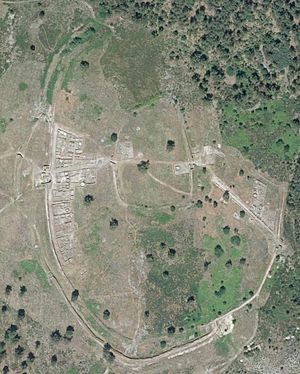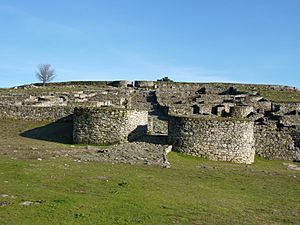Castro of San Cibrao de Las facts for kids
The San Cibrao de Las hill fort (also known as Castro de San Cibrao de Las) is an amazing ancient site in Galicia, Spain. It's not just a single castle, but a whole fortified town from long ago! This special place belongs to what historians call the castro culture.
People lived here for a long time, from about 200 BC to 200 AD. The town was most important around the first century AD. This was when the Romans first started to rule in Galicia.
The remains of this old town sit on a hill that is 473 meters high. The site itself is quite large, stretching 384 meters long and 314 meters wide. What makes San Cibrao de Las unique is its many straight walls. Most other hill forts in the area have more curved buildings.
Contents
What is a Hill Fort?
A hill fort is an ancient settlement built on top of a hill. People chose hills for safety. The higher ground made it easier to defend against enemies. These forts were often surrounded by strong walls or ditches.
Why Were Hill Forts Built?
People built hill forts for several reasons:
- Protection: They offered a safe place from attacks.
- Control: From a hill, people could see far and control the land around them.
- Community: They were home to many families, acting as small towns.
Exploring San Cibrao de Las
San Cibrao de Las is a great example of a castro, which is the Spanish word for a hill fort. This site shows us how people lived thousands of years ago. Archeologists have learned a lot by studying its ruins.
How Big Was the Town?
The town was very large for its time. It covered an area of about 12 hectares (around 30 acres). This size suggests it was an important center. Many people lived and worked within its walls.
What Did the Buildings Look Like?
Unlike many other castros with round houses, San Cibrao de Las has many straight walls. This might show Roman influence. The Romans often built with straight lines. Archeologists have found remains of houses, streets, and public spaces.
The Walls and Gates
The fort had strong defensive walls. These walls protected the town from invaders. The main gate, shown in one of the pictures, was very impressive. It was a grand entrance to the town.
Life in the Castro Culture
The castro culture was common in northwestern Spain and Portugal. People lived in these fortified villages. They were skilled farmers and craftspeople.
Daily Life in the Fort
Life in San Cibrao de Las was busy. People farmed the land outside the walls. Inside, they made tools, pottery, and clothes. They traded goods with other communities.
The Roman Influence
When the Romans arrived, they brought new ideas. They built roads and introduced new ways of building. San Cibrao de Las grew and became even more important during this time. The straight walls might be a sign of this Roman influence.
Why is San Cibrao de Las Important Today?
This ancient site helps us understand history. It shows us how people lived before modern times. Archeologists continue to study the ruins. They learn more about the castro culture and the early Roman period in Spain. Visiting the site is like stepping back in time!
See also
 In Spanish: Castro de San Cibrao de Las para niños
In Spanish: Castro de San Cibrao de Las para niños



